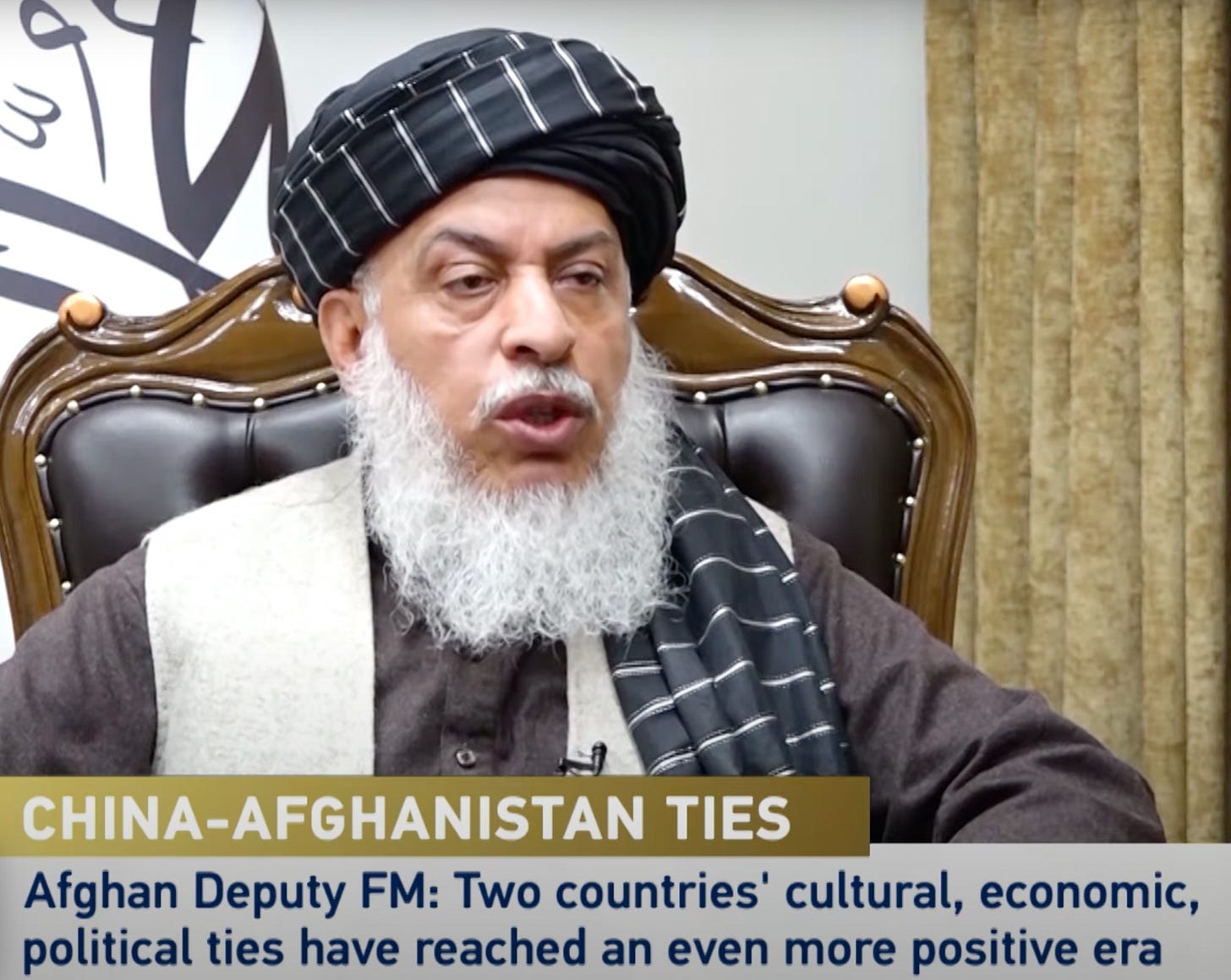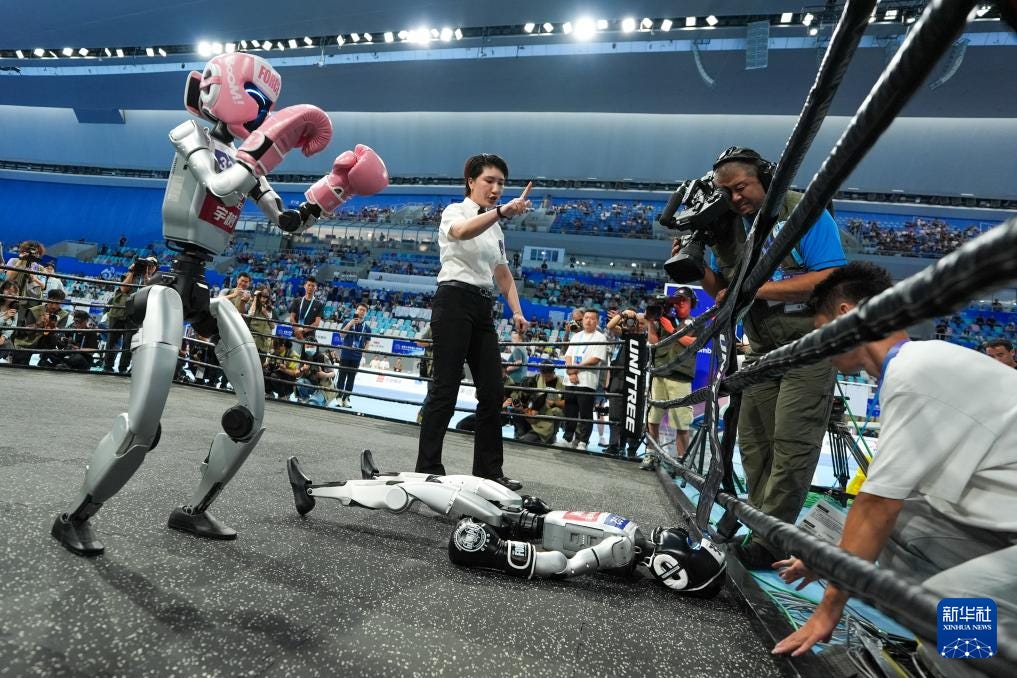China embraces India, Pakistan, Afghanistan
South Asian moves, Xi in Tibet, U.S.-China trade and tech wars, robot games, new visa to attract scientists, short video on broadcast TV, Nigerian bullet train, another diplomat disappears, and more.
Dear reader,
This week’s newsletter is going out on early Friday morning Beijing time. I usually send it between Tuesday and Thursday: Do you have a preference for a day? Do you care if the newsletter comes at exactly the same time each week? If you have thoughts, please let me know by replying to this email (or writing to jeremy@99words.com).
Two recommendations this week:
Has Trump gone soft on China—a ChinaFile Conversation that I worked on.
China watching in Chinese—A guide to Chinese-language analysis of Chinese politics by the Asia Society’s Shengyu Wang (now added to our guide on how to stay informed about China)
—Jeremy Goldkorn

Continental moves
China embraces India, Pakistan, Afghanistan, Xi in Tibet
On August 6, U.S. President Donald Trump said he would double tariffs on India to 50%, allegedly* to penalize Delhi for purchasing Russian oil. On August 18, Chinese Foreign Minister Wáng Yì 王毅 arrived in New Delhi for a short visit, during which he met Prime Minister Narendra Modi and Foreign Minister S Jaishankar—for only the second time since 2020 when deadly clashes in the Galwan valley in Ladakh, a disputed Himalayan border region, led to a complete breakdown of ties between the countries.
Official statements from both Beijing and Delhi have been positive, and included sunny statements about bilateral trade. In the Chinese readout of the meeting, Wang Yi calls India a “major power.” As Manoj Kewalramani notes, “It’s not customary for the Chinese side to refer to India as a ‘major power,’ a designation usually “held specifically for the U.S., Russia, and Europe.”
Wang Yi also confirmed that Modi will attend the Shanghai Cooperation Organization (SCO) summit in Tianjin from August 31 to September 1, which Vladimir Putin will probably join.
The takeaway: “Chinese readouts signal a cautious thaw,” say state-affiliated commenters Fred Gao and Gao Xirui. And as the U.S. retreats from its global role and engages in erratic acts of hostility such as the new tariffs on India, we can expect China’s relationship with many other countries ti improve.
Other news from the neighborhood:
After leaving India, Wang Yi traveled to Kabul to attend for the Sixth Trilateral Foreign Ministers’ Dialogue between Afghanistan, China, and Pakistan. He also met Afghan Prime Minister Muhammad Hasan Akhund. Wang said “Beijing was keen on exploring and mining minerals in Afghanistan and wanted Kabul to formally join its Belt and Road Initiative,” per Reuters.
Israeli media is reporting that Tehran is looking to China to rebuild its missile capabilities after the Twelve-Day War and U.S. bombing of nuclear facilities, but Beijing has “not confirmed it would replenish the Iranian arsenal.”
North of the Indian border, Xi Jinping and a large delegation visited Lhasa. The entire front page of the Party’s People’s Daily newspaper today is about the visit and the on the 60th anniversary of the founding of the Tibet Autonomous Region to consolidate Chinese rule. As the Wall Street Journal put it: “Xi reminds Tibet that Beijing is in charge.”
*Why would anyone believe that Trump’s new tariffs on India are about stopping Delhi from buying Russian oil? Trump has never led any punitive action against Putin, but he has been pushing around brown and black people—publicly—for sport since the 1970s.
Update: According to an August 30 New York Times report, Trump imposed the tariffs on India because he was enraged that Modi did not give him credit for “solving]” the decades-long military conflict between India and Pakistan.
U.S.-China trade and tech wars
Beijing doesn’t want your lousy chips
Rare earths: China “is telling companies they cannot go out and build huge inventories in rare earths, or they will face shortages”, reported the Financial Times. (“China dominates the production of rare earths, processing about 90% of the world’s supply and making 94% of permanent magnets. It has weaponized that control over the vital industry in the trade war with the U.S.”)
Chips: “ Nvidia is developing a new artificial intelligence chip for China based on its latest Blackwell architecture that will be more powerful than the H20 model it is currently allowed to sell there,” reported Reuters. But Beijing is not that excited: after last week asking Chinese companies to avoid purchasing Nvidia chips, this week state news agency Xinhua warned that the “United States’ practice of installing location trackers in chip shipments at risk of diversion to China reflects the ‘instincts of a surveillance empire.’”

The robots still have a way to go
The robot Olympics in Beijing
The first World Humanoid Robot Games took place in Beijing from August 15 to 17, with 280 teams from 16 countries playing sports and displaying their skills at menial labor.
It’s clear that robots are not yet ready to take all of our jobs: “stop-start hotel bellhops and a maid that missed the trash bin” are among the examples of robot fails noted by the Wall Street Journal. Contenders from Hangzhou’s Unitree Robotics seem to have performed best in the sport competitions. The Baiguan newsletter has compiled an illustrated review of the “best moments” from the event.
Making China great again
China creates new visa to attract scientists
As the Trump administration continues its attacks on science and on universities, China’s State Council has announced that young science and technology professionals would be able to apply for “young talent” K visas from October 1. The new visa will probably have an upper age limit of 40 or 45.
The endless scroll comes to TV
More short video on broadcast TV
China's broadcast authorities have relaxed rules on the censorship and regulation of TV dramas, apparently to encourage TV stations to more effectively compete with online video platforms.
The policies bode well for “drama content producers and long video platforms given likely more diversified content supply, shorter regulatory review time, and potentially more monetization potential,” according to financial analysts cited by the Wall Street Journal. This also “reflects the anxiety of a mobile and short-video dominated media environment,” says China consumer analyst Jiang Yaling.
High speed rail in Africa
China to fund Nigerian bullet train
Keep reading with a 7-day free trial
Subscribe to The China Week to keep reading this post and get 7 days of free access to the full post archives.

